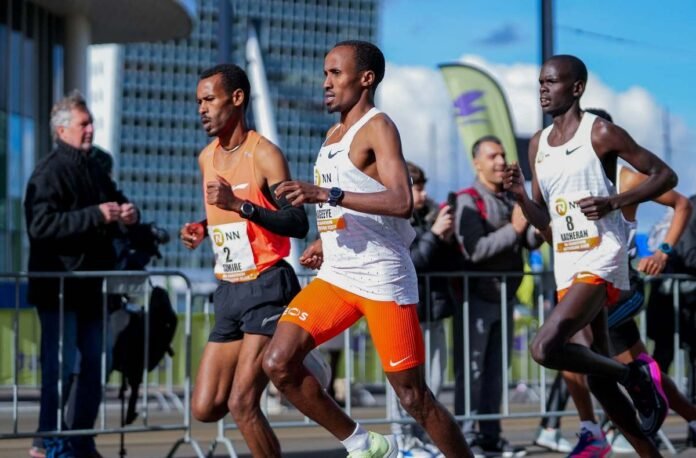Dutch runner Abdi Nageeye wears a CGM (continuous glucose monitor) on his upper left arm as he participates in the 2022 Rotterdam Marathon, in Rotterdam, Netherlands, April 2022.
12:06 JST, June 11, 2024
Olympians, including Dutch marathoner Abdi Nageeye, are using a new tool they hope will boost their medal chances this summer: small monitors that attach to the skin to track blood sugar levels.
Continuous glucose monitors, or CGMs, were developed for use by diabetes patients, but their makers, led by Abbott ABT.N and Dexcom DXCM.O, are also eyeing possibilities in sports and wellness.
The Paris Olympics, which start on July 26, are a chance to showcase the technology – even if there is no evidence yet that it can improve athletic performance.
“I foresee a day when CGM will certainly be used extensively beyond the diabetes industry,” said Jacob Leach, Chief Operating Officer of Dexcom.
Diabetes patients remain the CGM specialist’s commercial focus, he told Reuters, but Dexcom is also working with researchers on future uses to optimize athletic performance. He does not want to reveal details.
The CGM market is already worth billions of dollars thanks to demand from diabetes patients, who use the coin-sized adhesive skin patches with a Bluetooth link to a smartphone instead of drawing blood through a finger prick. The measurements help determine whether they need an insulin dose.
In March, Dexcom’s Stelo device, aimed at people with early-stage diabetes who don’t use insulin, became the first CGM to receive approval for purchase without a prescription in the US. The launch is scheduled for this summer.
Abbott introduced a CGM product for amateur and top athletes without diabetes in Europe in 2020 and has sponsored Kenyan marathon great Eliud Kipchoge and his team since 2021. Elite athletes and their support staff use CGMs to optimize caloric intake and exercise intensity as they prepare for sporting events.
Abbott said it is targeting the non-diabetic consumer market.
On Monday, it received U.S. approval for its over-the-counter Lingo health and wellness device and smartphone app, which has been available in Britain since January at a price of 120 to 150 pounds ($152-$190) per month.
Also on Monday, Abbott received U.S. approval for its Libre Rio prescription over-the-counter system for people with diabetes who don’t need insulin, to compete with Dexcom’s Stelo.
Sales of Abbott’s FreeStyle Libre range, the most widely used CGMs, increased 23% to $5.3 billion in 2023 on demand from diabetes patients who value ease of use and monitoring precision. Dexcom saw revenue grow 24% to $3.6 billion in 2023.
Research firm GlobalData predicts that the lifestyle CGM market could grow nearly 15% annually to $9.9 billion by 2031, driven in part by weight-loss drug users like Wegovy looking for medical gadgets to aid diets.
Other market researchers estimate that the overall CGM market, including diabetes use, with suppliers like MedtronicMDT.N , will grow 9-10% annually over the next five years.
PREPARATION FOR PARIS
Dutch marathoner Nageeye, who won silver at the Tokyo Olympics, said he and his coaches monitor blood glucose as an indicator of the body’s available energy as part of his quest for an “effortless run.”
The use of CGM has guided Nageeye, who has qualified for Paris, to work on sleeping and eating patterns so that he uses minimum energy during training.
“That’s actually your energy, that’s your fuel. We have to keep an eye on that,” said Nageeye. His team has been sponsored by Abbott since April 2021.
Australian swimmer Chelsea Hodges, who won relay gold at the Tokyo Olympics, said CGMs had helped her overcome bouts of extreme exhaustion and dizziness during endurance training by making adjustments to her calorie intake and training times.
She spoke to Reuters as she prepared for Paris but recently ended her swimming career due to hip problems.
While companies see growth potential in the gadgets, sports nutrition scientists see a promising area of research.
“The big guesswork for endurance athletes has always been: am I training hard enough or am I training too hard? It seems that with CGMs we have a better understanding,” says Associate Professor Filip Larsen from the Swedish School of Sports and Health Sciences.
Larsen, who is also chief science officer of sports performance consultancy svexa, said the company has analyzed CGM data collected by various athletes and teams. He said svexa is not sponsored by any CGM maker.
However, Larsen cautioned that little validated science exists on how to optimize an athlete’s routines using CGMs.
“Most researchers can’t give you the exact answers. In five years we will know ten times as much as we know now.”
But the field is abuzz with research and experiments, including work on contact lenses that measure glucose.
Sports dietitian Greg Cox, associate professor at Australia’s Bond University, has worked with swimmers including Hodges and rowers, triathletes and track athletes.
Results of a trial conducted by his team to test how not eating enough calories to maintain exercise intensity would affect endurance athletes’ glucose readings have so far been inconclusive, and he said more research is needed to CGMs was necessary.
Both Cox and Larsen expressed skepticism about non-diabetic consumers using health and fitness technology without professional advice.
“What I see on social media is that normal, healthy people get scared if they eat one banana and their blood glucose rises very high for an hour. This is completely expected and a normal reaction,” Larsen said.
Industry leader Abbott told Reuters that understanding blood glucose fluctuations is key to controlling metabolism for a healthier life.
“While glucose spikes are normal in healthy people, we also know that having less frequent and large spikes and dips in glucose is associated with improved energy, mood, focus, sleep and reduced cravings,” a spokesperson said.
$1 = 0.7863 pounds



